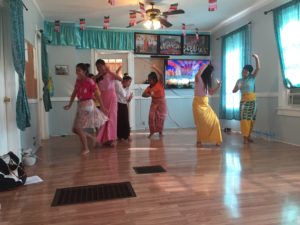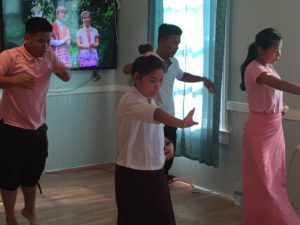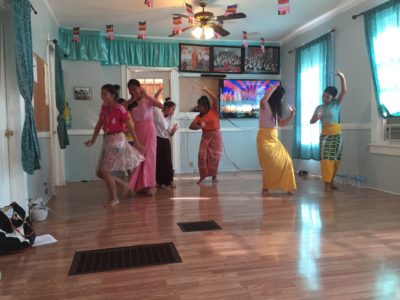NAME: Karen
ART FORM: Don Dances
REGION: Border Region of Burma and Thailand

BACKGROUND
The Karen are a group of people that occupy the region between the Burma-Thailand border. They are their own separate nationality but do not have their own country to call home. Rather, for many years they have straddled this border region constantly facing political and military pressures from either country. The Karen wants autonomous rule and its own nation-state, but neither Burma nor Thailand is willing to relinquish land to them. Their situation is very similar to that of the Kurds of the Iran-Iraq-Turkey region.
DON DANCES
The Karen has endured poor treatment from both countries for a long time. To combat these hardships and persevere their own culture, the Karen find solace in their traditional dances. They call these dances Don Dances. As Mu Mu, a Karen teenager living in Syracuse, said “Our dance is about freedom. Our people don’t have their own country. People are either killed or forced to move. It’s a way of showing off our culture.” In the midst of turmoil, the Karen find strength in their traditional dance.
Don Dances symbolize unity and strength. The dance creates a sense of community for a people that don’t have a country to call their own. Everyone from young children to the older adults participates in the dances. It is all-inclusive which further perpetuates the idea of a community imagined.
A Don Dance is distinct to the Karen. If others saw the choreography, they would be able to identify it with the Karen. The dance not only shows off their culture, it preserves their culture. The movements are passed down from generation to generation. More so, it is a way of celebrating who they are as individuals and a nationality when for so long they have been subjugated to poor treatment.
The confidence and pride symbolized in the dance are easily seen during a performance. Introverts become extroverts. Dancers find strength from their fellow dancers. Minor insecurities are forgotten in the midst of dancing with so many other Karen. Even the choreography lends itself to being confidence inducing. Each dance tends to incorporate lots of wrist flicks and up and down motion.
The choreography contains a bit of flair too. The wardrobe helps extenuate the pride they feel. The colors are bright and reminiscent of springtime. Plus, they wear a cloth around their wrist that whips back and forth as they flick their wrists.
Don dances are performed on all occasions but none are as significant as the Karen New Year. The new year is celebrated from January 1st – 31st. This is the biggest holiday for the Karen. Music, dancing, games, and even poetry are performed as a celebration.
DEMOGRAPHICS
The Karen is the third biggest ethnic group in Myanmar after the Bamar and Shans. There are varying figures regarding their worldwide population, but multiple reports indicate that the range is from 7-8 million people worldwide. While the Karen hail from the land between Burma and Thailand the population distribution is not even. Burma accounts for about 85% of the world Burmese population or around 6,000,000 people. Thailand hosts about 14% of the population, which is just fewer than 1,000,000 people.
The Karen are primarily Buddhist; however, after Christian missionaries came to Southeastern Myanmar in the mid 19th century, a small population of Karen converted to Christianity. There are four languages that the Karen speaks: S’gaw Karen, Pwo Karen, Karenni, and Pa’O.

The Burmese government has historically displaced The Karen by burning Karen land. This prompted the creation of the KNU, Karen National Union. It is a militaristic organization that has fought against the Burmese government since the middle of the 20th century. Due to this violent conflict, many Karen has emigrated elsewhere. The largest contingency of Karen outside of the Karen State lives in the U.S. The United State Karen population is estimated at about 70,000 people nationwide.
On a local level, according to the Steinhardt School at New York University, there were around 11,000 Karen in New York in 2010. In Central New York alone there are 7,000 Karen. The population is split up between Ithaca, Syracuse, Rome, and Utica. The different communities of Karen do not interact often; however, they do come together for their New Years celebrations. Each community will perform a dance for the other among other celebrations.
For a longer video with all the clips combined, watch the video below!
Sources:
“Karen Cultural Profile.” Karen Cultural Profile – Ethnomed, ethnomed.org/culture/Karen/lare-cultural-profile. Accessed 20 Sept. 2017.
MacLachlan, Heather. “The Done Dance: An Expression Of Karen Nationalism.” The Don Dance: An Expression Of Karen Nationalism, www.nyfolklore.org/pubs/voic32-3-4/dondance.html. Accessed 20 Sept. 2017.
“Karen People.” Wikipedia, Wikimedia Foundation, 20 Sept. 2017, enwikipedia.org/wiki/Karen_people. Accessed 20 Sept. 2017.
TWC News. www.twcnews.com/nys/central-ny/news/2016/01/21/new-store-shares-karen-cuture-with-syracuse-community.html Accessed 20 Sept. 2017.
Steinhardt School, NYU. “Building a New Life: Burmese Refugees and their Resettlement” https://steinhardt.nyu.edu/scmsAdmin/uploads/005/650/3-27,_Albany%20-%20Presentation.pdf. Accessed 21 Sept. 2017
